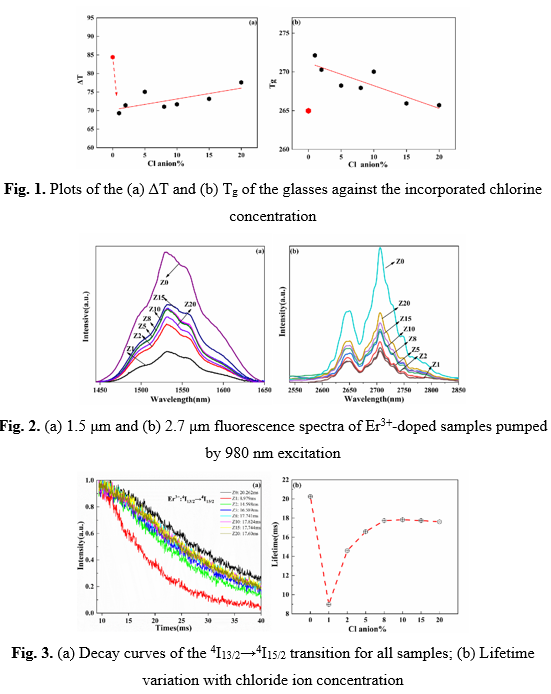Because of the wide transmission windows ranging from the ultraviolet (UV) to the mid-infrared region and low phonon energy (300-400cm-1), heavy metal fluoride glass has become an ideal host material for rare-earth (RE) ions.
To tackle the major problems of low stability and fibrillation, the properties of fluoride glass modified by the partial substitution of Cl- and Br- for F- is a trend in current research. So far, many studies are focusing on the effect of Cl- on fluoride glass. Unfortunately, there is no definite rule for the effect of chlorine ions on fluoride glass.
Recently, a research team led by Professor ZHANG Long from Key Laboratory of Materials for High Power Lasers, Shanghai Institute of Optics and Fine Mechanics of the Chinese Academy of Sciences, has systematically studied the effect of chloride ions on Er3+-doped fluoride glass.
The series of components designed by them for this experiment were 80. The 36 g glass batch was weighed and 4 g of NH4HF2 was added to provide a protective atmosphere. Using conventional melt-quenching techniques, the mixtures were melted at 850°C for 30 min, then were poured on a preheated 230°C brass mold and annealed for 5 h to remove stress.
They discovered the phenomenon of mutation of the glass performances for the first time. The DTA results showed the value of ΔT falling from 84.4°C to 69.3°C after the addition of 1 mol% Cl- for modification, which indicates that the glass-forming ability significantly decreased. However, with the increase of Cl- content, ΔT shows an increasing trend until the content of Cl- up to 20 mol%, of which the value of ΔT closed to Z0.
Furthermore, the fluorescence properties of glass exhibit the similar trends, such as the fluorescence intensity and lifetime for 1.5μm. They explained this special phenomenon from the changes of the structure and the Judd-Ofelt theory of glass before and after halogen anion substitution. This research could provide a new reference for the anion modification of fluoride glass.
The work, entitled" Non-linear changes of performances caused by introduction of chloride ions into Er3+-doped fluorozirconate glass", was published in Ceramics International on Nov.15, 2018.

(Image by SIOM)
Article website:
https://www.sciencedirect.com/science/article/pii/S0272884218332383?via%3Dihub
Contact:
Mr. Cao Yong
General Administrative Office
Shanghai Institute of Optics and Fine Mechanics, CAS
Email: caoyong@siom.ac.cn